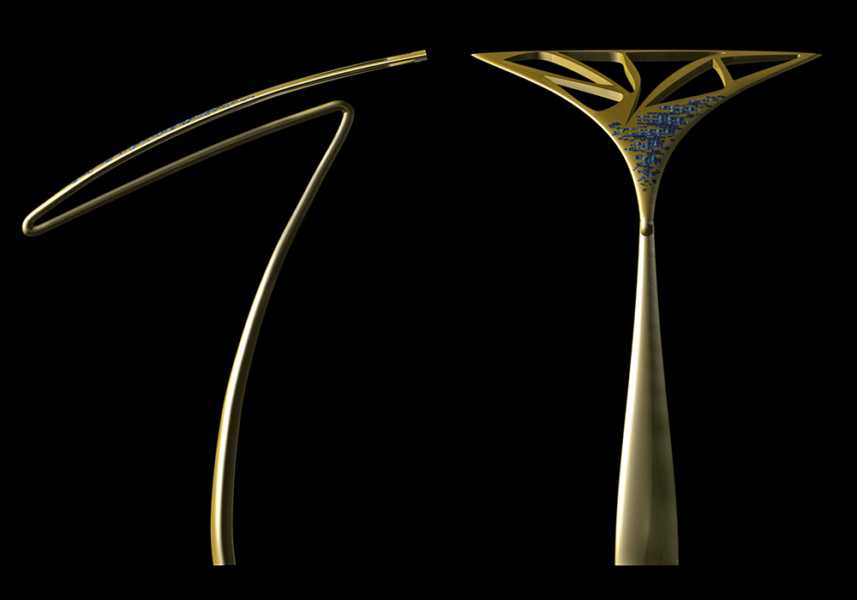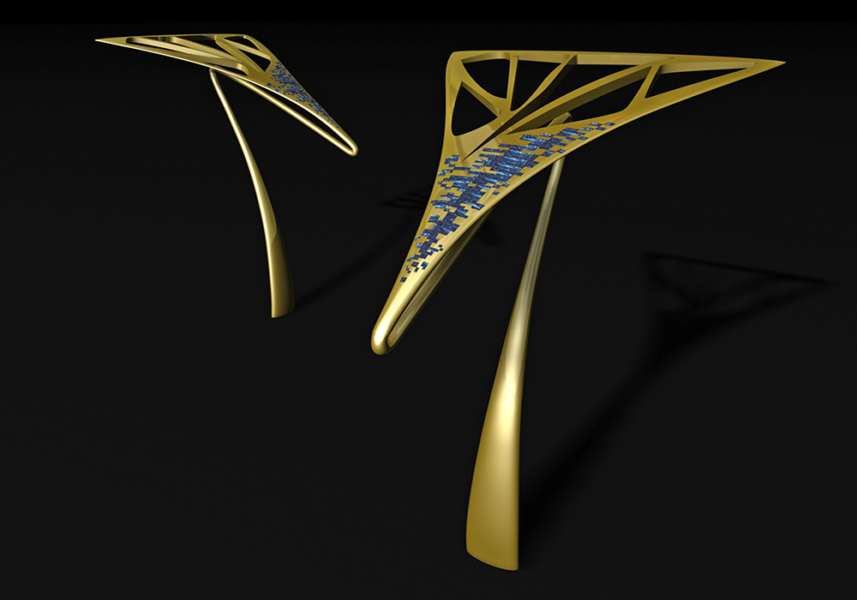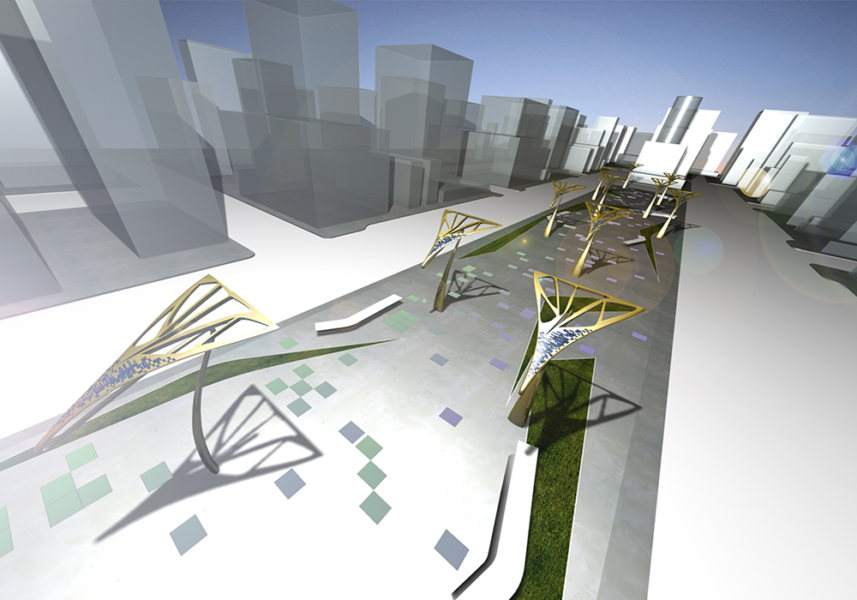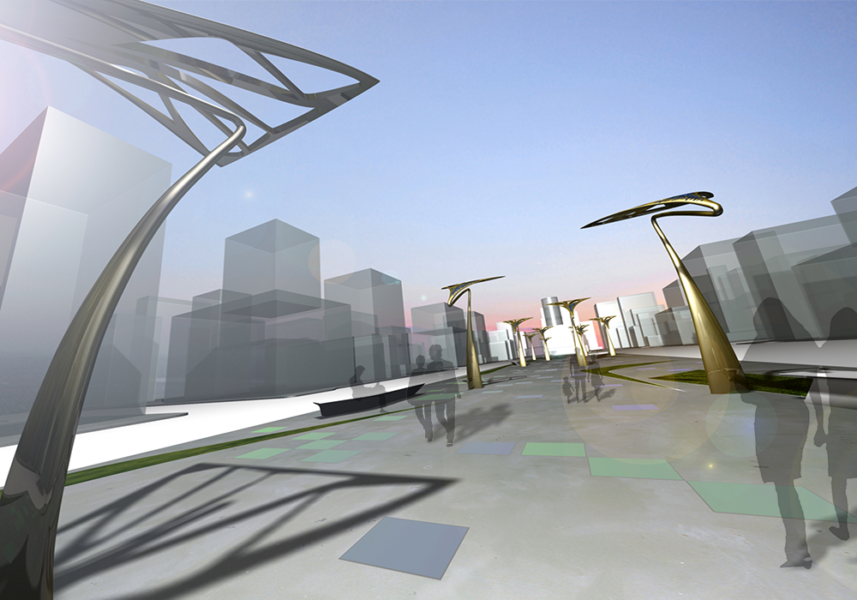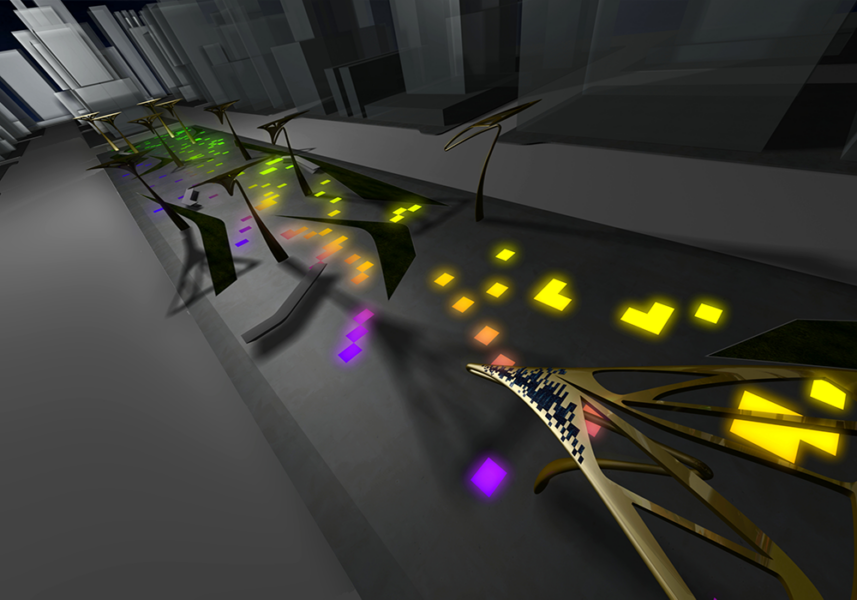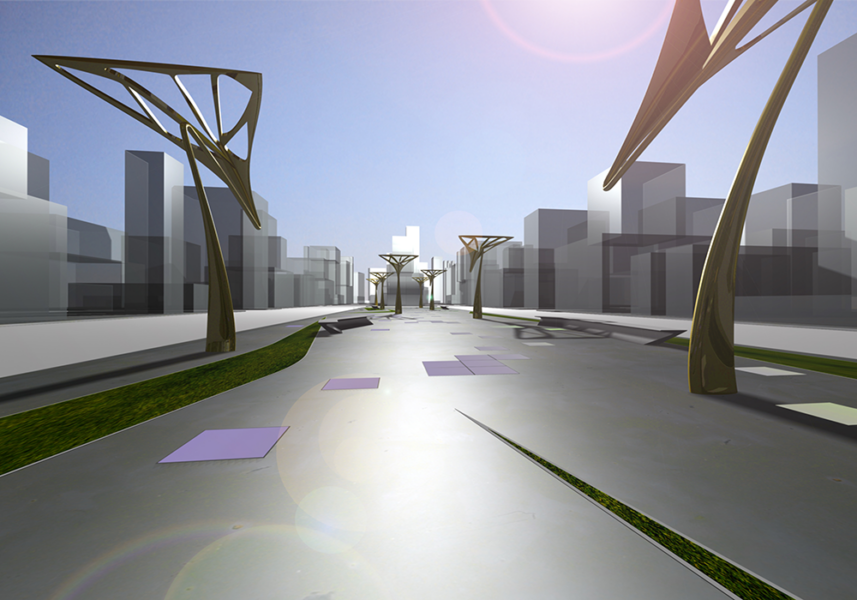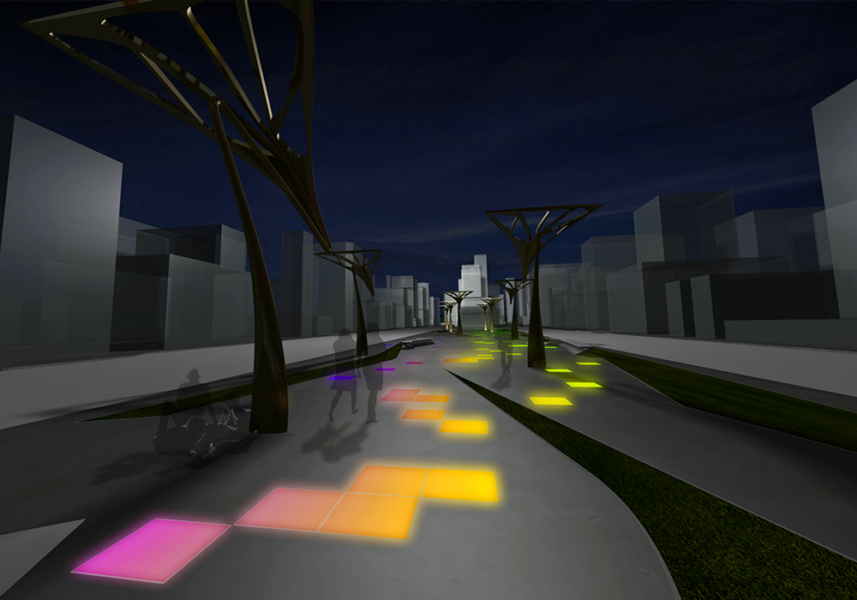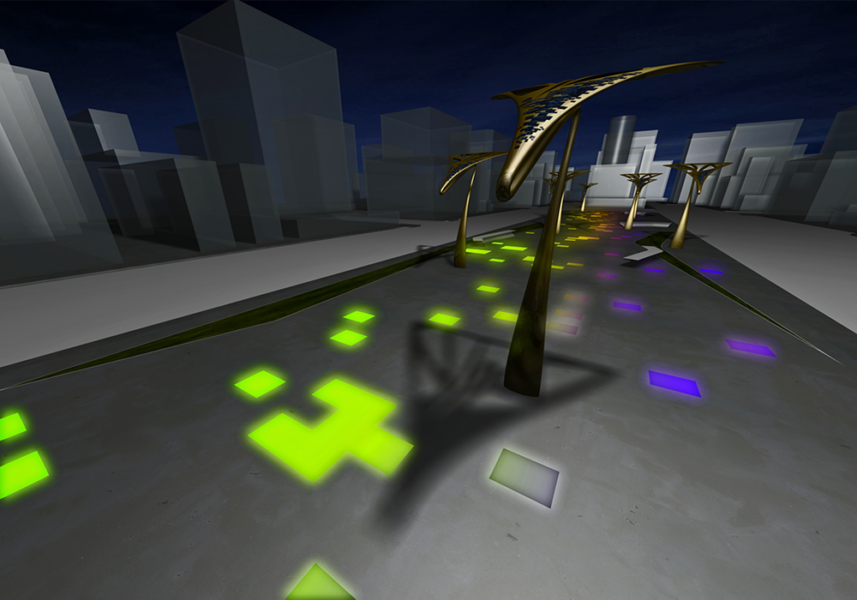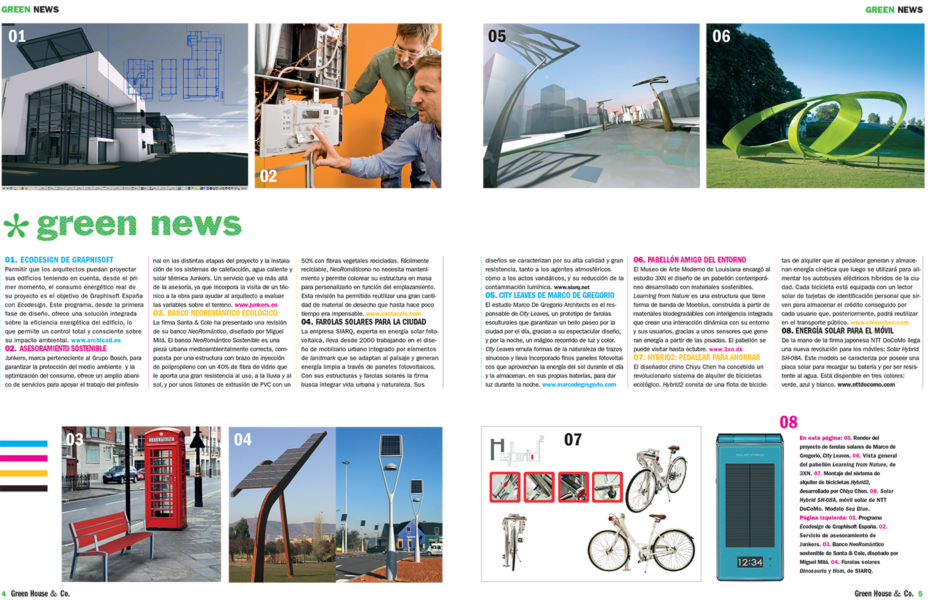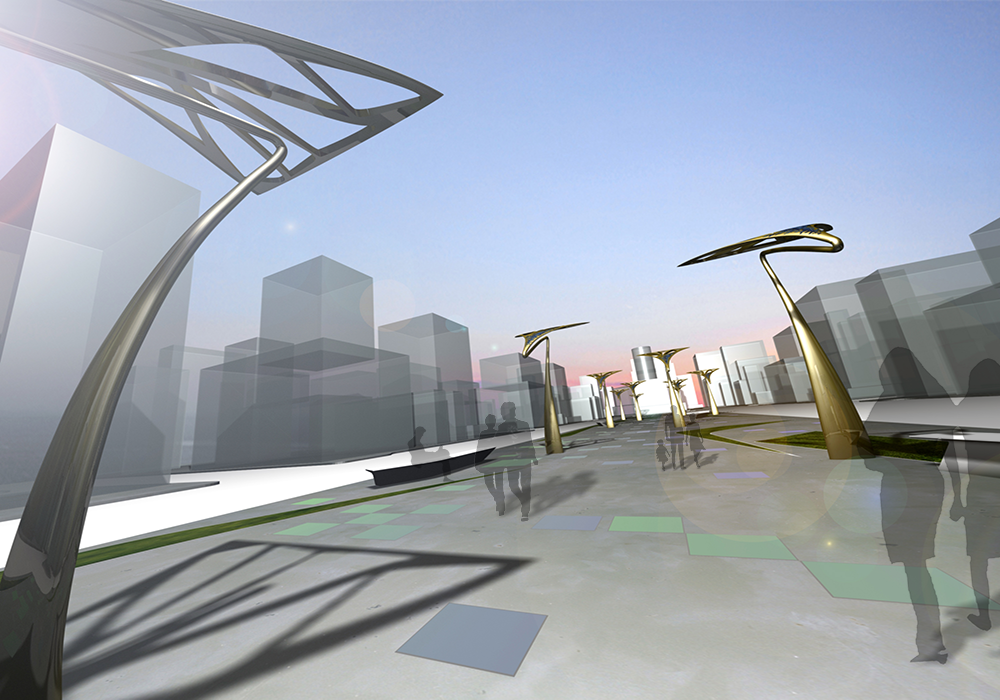
City Leaves
2009
Project proposal
Marco De Gregorio Architects
City Leaves
City Leaves is a project concept, a research about the valorization of the
public space and an idea that introduces an echo-lighting system for the
streets of tomorrow.
The design of the public illumination, in particular the “clean light”, has not be
regarded. Above all designers and companies have the habitude to design
light for the interior not for outdoor urban places.
12 Urban photovoltaic sculptures that besides diminishing the carbon
omission they describe a stimulating and desirable city passage.
The design of each of the 12 structures, scattered on a surface of 1.350sq.
m, is developed in a single gesture and is an organic inspiration following the
morphology of the leaves and its ribs or leave structure.
These ribs allows the articulation of play of light and shadow, like sunlight
filtering through the branches.
They are a metaphor of the life, like the trees that open their leaves in
sunlight in order to breath, thus these large” leaves” capture the light in order
to give back it during the night.
Each structure is 5 meters tall with a canopy size of 3,2 by 3,7 meters.
Their material is casted in aluminum (colour given according to the place of
installation, genius loci) accessible, light weight, affordable and easy to
recycle.
On the top part of the structure, on the canopy, there is a thin film of solar
cells in epitaxial silicon that covers a surface of approximately 2,5 sq. m.
The total of the photovoltaic surface is: 2,5 sq. m x 12 canopy is equal to 30
sq. m.
-Solar cells in epitaxial silicon are less expensive than the solar cells based on volumetric
silicon.
However, the main disadvantage of these cells of epitaxial silicon is technically inefficient.
Being entirely composed by silicon of high purity, the production of this type of solar cells are
very efficient and relatively expensive.
The surface is treated into a plasma state and a mirror of porous silicon is inserted.-
We omit the laws, because there might be different regulations aspect in
every country and even between different regions. There exist various
physical and geographic datas to determine variations in the fields of the
photovoltaic solar panels, like the surface to exposure to sunlight that
accommodate the panels, the latitude and the radiation.
As an example the annual medium insulation in the zone of Milan is 1.372.4
kWh/m ², in Rome 1,737 kWh/m ² and in Trapani 1,963 kWh/m ².
To summarize, we take in consideration the percentages of the efficiency of
the modules FV, the losses due to the transfer of the energy so we gain
energy on every square meter of photovoltaic solar panels respectively:
Milan 146 kWh, Rome 184 kWh and Trapani 208 kWh in a year .
Arch. Marco De Gregorio
Barcelona, Espana www.marcodegregorio.com – degregoriomarco@gmail.com
For the general illumination of the square, reloadable photovoltaic batteries
feed the LED lights in the pavement.
The layout of the LED lighting resembles as disorganized pixels in a grit, in
approximately an amount of hundred. The lights emit a diffused colourfull
light, pleasant and safed.
LED is the acronym of Light Emitting Diode and has the positive
characteristic to use 85% less energy than conventional filament bulbs and
50% less than the fluorescent ones.
By using less consuming lighting systems one obtain a reduction in the
emissions of gas and mercury.
Other advantage of the LED lights is the long duration which is circa 50,000
hours or more.
Normally our streets and our squares are illuminated from headlights and
lamps of 150W/300W. Using the LED lights we could obtain the same power
of brightness respectively with lamps of circa 20W/40W.
Through new studies, the luminous efficiency light amount/consumption
(lm/W) has been calculated to a minimum of 3 to 1.
If the project City Leaves was implemented in the city of Rome, it would
succeed to produce approximately 5500kWh per year.
We would thus have sufficient light to illuminate a public space during the
night without having the problem of luminous pollution, waste of money,
energy and emission of CO2.
Moreover this type of architectonical intervention can illuminate roads and
places far from the city power network.
The photovoltaic modules produce the necessary electric power to charge
energy, allowing to save costs of connection to the existing power network.
It can be placed and work every environment.
The construction and the planning of a structure with photovoltaic modules
seems to be a costly investment but on the long run the economical and
environmental advantages will be obvious.
By researching new sustainable materials and solutions,
architects and designers can increase the general awareness in design
products in order to boost an economical process of supply and demand on
the market.
It is to encourage promoters, sponsors and companies that can help to
develop project of quality, architectonically and socially
public space and an idea that introduces an echo-lighting system for the
streets of tomorrow.
The design of the public illumination, in particular the “clean light”, has not be
regarded. Above all designers and companies have the habitude to design
light for the interior not for outdoor urban places.
12 Urban photovoltaic sculptures that besides diminishing the carbon
omission they describe a stimulating and desirable city passage.
The design of each of the 12 structures, scattered on a surface of 1.350sq.
m, is developed in a single gesture and is an organic inspiration following the
morphology of the leaves and its ribs or leave structure.
These ribs allows the articulation of play of light and shadow, like sunlight
filtering through the branches.
They are a metaphor of the life, like the trees that open their leaves in
sunlight in order to breath, thus these large” leaves” capture the light in order
to give back it during the night.
Each structure is 5 meters tall with a canopy size of 3,2 by 3,7 meters.
Their material is casted in aluminum (colour given according to the place of
installation, genius loci) accessible, light weight, affordable and easy to
recycle.
On the top part of the structure, on the canopy, there is a thin film of solar
cells in epitaxial silicon that covers a surface of approximately 2,5 sq. m.
The total of the photovoltaic surface is: 2,5 sq. m x 12 canopy is equal to 30
sq. m.
-Solar cells in epitaxial silicon are less expensive than the solar cells based on volumetric
silicon.
However, the main disadvantage of these cells of epitaxial silicon is technically inefficient.
Being entirely composed by silicon of high purity, the production of this type of solar cells are
very efficient and relatively expensive.
The surface is treated into a plasma state and a mirror of porous silicon is inserted.-
We omit the laws, because there might be different regulations aspect in
every country and even between different regions. There exist various
physical and geographic datas to determine variations in the fields of the
photovoltaic solar panels, like the surface to exposure to sunlight that
accommodate the panels, the latitude and the radiation.
As an example the annual medium insulation in the zone of Milan is 1.372.4
kWh/m ², in Rome 1,737 kWh/m ² and in Trapani 1,963 kWh/m ².
To summarize, we take in consideration the percentages of the efficiency of
the modules FV, the losses due to the transfer of the energy so we gain
energy on every square meter of photovoltaic solar panels respectively:
Milan 146 kWh, Rome 184 kWh and Trapani 208 kWh in a year .
Arch. Marco De Gregorio
Barcelona, Espana www.marcodegregorio.com – degregoriomarco@gmail.com
For the general illumination of the square, reloadable photovoltaic batteries
feed the LED lights in the pavement.
The layout of the LED lighting resembles as disorganized pixels in a grit, in
approximately an amount of hundred. The lights emit a diffused colourfull
light, pleasant and safed.
LED is the acronym of Light Emitting Diode and has the positive
characteristic to use 85% less energy than conventional filament bulbs and
50% less than the fluorescent ones.
By using less consuming lighting systems one obtain a reduction in the
emissions of gas and mercury.
Other advantage of the LED lights is the long duration which is circa 50,000
hours or more.
Normally our streets and our squares are illuminated from headlights and
lamps of 150W/300W. Using the LED lights we could obtain the same power
of brightness respectively with lamps of circa 20W/40W.
Through new studies, the luminous efficiency light amount/consumption
(lm/W) has been calculated to a minimum of 3 to 1.
If the project City Leaves was implemented in the city of Rome, it would
succeed to produce approximately 5500kWh per year.
We would thus have sufficient light to illuminate a public space during the
night without having the problem of luminous pollution, waste of money,
energy and emission of CO2.
Moreover this type of architectonical intervention can illuminate roads and
places far from the city power network.
The photovoltaic modules produce the necessary electric power to charge
energy, allowing to save costs of connection to the existing power network.
It can be placed and work every environment.
The construction and the planning of a structure with photovoltaic modules
seems to be a costly investment but on the long run the economical and
environmental advantages will be obvious.
By researching new sustainable materials and solutions,
architects and designers can increase the general awareness in design
products in order to boost an economical process of supply and demand on
the market.
It is to encourage promoters, sponsors and companies that can help to
develop project of quality, architectonically and socially
